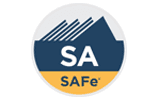SAFe 6.0 Certification Training Course Overview Chennai
SAFe (Scaled Agile Framework) is a popular methodology that helps organizations to effectively scale agile practices across various teams and departments. SAFe Agilist 6.0 Certification Training is a comprehensive course that teaches participants the fundamental principles of SAFe, including its various layers and roles, and how to apply them in real-world scenarios.
The course is designed for individuals who want to lead agile transformation initiatives within their organizations or who want to gain a better understanding of SAFe's key principles and practices. It covers a range of topics, including agile development, DevOps, Lean product development, and more.
The SAFe Agilist 6.0 Certification Training is structured around a combination of lectures, hands-on exercises, and group discussions. Participants will learn how to create and manage agile teams, plan and execute agile projects, and optimize the flow of value through their organizations.
Upon completion of the course, participants will be able to take the SAFe Agilist 6.0 Certification exam, which is a multiple-choice test that measures their understanding of SAFe principles and practices. Those who pass the exam will receive a SAFe Agilist 6.0 Certification, which is widely recognized by organizations around the world.
Overall, the SAFe Agilist 6.0 Certification Training is a valuable course for anyone looking to develop their agile skills and advance their career in agile development and project management.
Loading...
SAFe Agile Certification Course Objectives
• Understand how Lean, Agile, and the product development process form the foundation of a complete agile framework. Apply the SAFe® values of Lean-Agile thinking process to promote Lean/Agile in your business.
• Discover/Apply Lean-Agile principles/thinking and become a Lean-thinking manager.
• Configure, deploy, and unlock value to support PI scheduling and runtime events.
• Enhance the Lean portfolio by applying Lean-Agile principles to the SAFe® role/principles. Know the seven core competencies of SAFe® 5.1 and collaborate on the development of quality solutions.
• Improve Lean-Agile leadership skills.
• Build focused, high-performance agile teams.
• Start a Lean-Agile transformation in your business through the SAFe® Deployment Roadmap.
• Ensure alignment/deployment with Lean Strategy and Portfolio Management modules.
SAFe Agile Course Target Audience
• An entry-level individual in the Scaled Agile Framework®
• Professionals who want to scale Agile across teams and drive change within Scrum teams.
• Professionals who want to engage in large-scale product/solution development using SAFe.
• Professionals looking to upgrade their skills to meet rapidly changing market trends by earning SAFe Agilest certification.
Prerequisite to Attend SAFe Agile Training Course in Chennai Tamilnadu
• No mandatory prerequisites for attending the course.
• It is highly recommended that participants have a solid understanding of agile concepts and principles. In addition, it would be beneficial for participants to have prior knowledge of Scrum, Kanban, eXtreme Programming (XP), as well as a working knowledge of software and hardware development processes.
Course Outline
Thrive with Business Agility
Scaled Agile Framework's motive is to align/collaborate, synchronize, and coordinate the release of solutions created by various Agile teams. In an Agile development environment, the SAFe framework lets the team increase/decrease the requirement depending on the organizational needs. It enables cross-functional/organizational teams to deliver products on time using the necessary scaling support.
• Explaining What's Essential for Thriving in the Digital Age.
• Acknowledging SAFe as an Operating System for Business Agility.
• Summarizing the Core Competencies of Business Agility.
Learn SAFe Core Values & Lean-Agile Principles
Nine fundamental SAFe Principles:
• Economic Approach.
• Relating to the System Thinking Method.
• Presuming Inconsistency and Maintaining the Choices.
• Building Increments Quickly and Using Incorporated Learning Cycles.
• Evaluating the Objective of the Working System and Marking them as Milestones.
• Controlling the Backlog Size, Minimizing the Batch Size, Foreseeing and Restricting WIP.
• Coordinating with the Cross-domain Planning and Maintaining an Appropriate Tone.
• Releasing the Natural Enthusiasm of Skilled Team Members.
• Distributing the Decision Making and Allowing Every Individual to Think.
Establish Team & Technical Agility
Cross-functional Agile teams promote Agility, and they are also the basis of any Agile framework.
• Preparing to Form Cross-functional Agile Teams.
• Describing Built-in Quality Practices.
• Recommending Organizing Around Value with Agile Release Trains (ARTs).
Agile Product Delivery with SAFe
The Agile Release Train (ART) distributes incremental value in the form of developed/tested software and system in a time-boxed duration. This is known as Program Increment. Each PI uses harmonization to smoothen the progress in planning, summarizing the value for feedback, restricting the work in progress (WIP), and guaranteeing program-level retrospectives with consistency.
Get used to the PI planning methodology with better portfolio management and road mapping scope. Learn the best ways for applying DevOps to build/maintain a constant delivery pipeline. This provides the workflow, activity, and automation needed for offering a constant release of value to the customer.
• Exploring Customer Needs.
• Integration.
• Deploying with DevOps.
• Releasing on Demand.
• Improving Results.
Lean Portfolio Management
Know the correct way for scaling SAFe practices/principles across multiple SAFe portfolios.
• Explaining the Purpose/Elements of a SAFe Portfolio.
• Constructing Well-written Strategic Themes.
• Employing the Portfolio Canvas for Describing the Current/Future State.
• Creating Epic Hypothesis Statements to Inform the Vision.
• Distinguishing Traditional and Lean Budgeting Approaches.
• Constructing a Portfolio Kanban.
Lead the Changes
Leaders, executives, and managers are responsible for the adoption, success, and improvement of Lean-Agile development. They carry authority for changing and continuously improving the systems that govern work-performance.
• Learning the Behaviors Required for Leading by Example.
• Exploring Techniques for Leading Successful Change.
• Identifying the Steps in the SAFe Implementation Roadmap.
Choose Your Preferred Mode

SAFe Agile Certification Chennai Training Course
- Instructor led Online Training
- Quality Ensured training Material
- 24*7 leaner assistance and support
- Experienced Trainers

SAFe Agile Framework Corporate Training
- Customized SAFe Training Across Various Domains
- Instructor Led Skill Development Program
- Ensure Maximum ROI for Corporates
- 24*7 Learner Assistance and Support
FAQ’s
Who conducts the SAFe Agile Certification Training session in Chennai?
We have certified trainers who have practical experience in specific areas.
Can I cancel the course after paying online?
Yes, candidates must provide at least 4-5 days prior information if they do not wish to continue the course. But once the course starts, no refund will be issued.
Is Vinsys an accredited partner offering SAFe Agile Certification Training courses in Chennai?
Yes, Vinsys is an accredited partner.
Does Vinsys offer end-to-end SAFe exam support?
Yes, trainees can receive excellent support from Vinsys experts.
How is the SAFe Agile Course at Chennai conducted?
This SAFe course is instructor-led online learning. Offline and Classroom Training also available.
What's the Passing Score in SAFe Exam?
The passing score of SAFe exam is 99%.
Why select Vinsys as you training partner for the SAFe 6.0 Training?
In addition to being a well-known IT training service provider for individuals/enterprises in the industry, Vinsys is also considered a top destination for SAFe courses. Its unparalleled services, vendor-approved instructors, customizable skills program, and round-the-clock learner support ensure the most intensive skill-enhancing experience needed to open up for valuable agile business opportunities.
Why Vinsys

Find This Certification Course In Other Top Cities
Reviews
It was a great experience to take SAFe agile training chennai at Vinsys. The instructor was so humble and solved all my queries whenever I asked to them. Big thanks to Vinsys.
The SAFe Certification training was wonderful course for gaining the deep understanding of SAFe agile framework.


